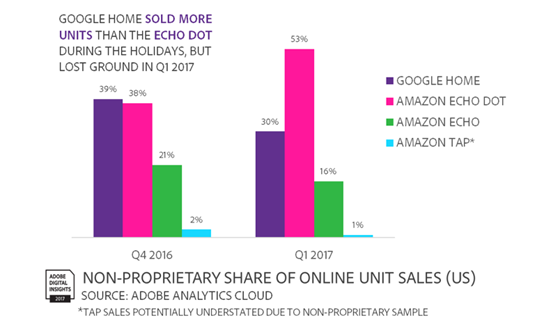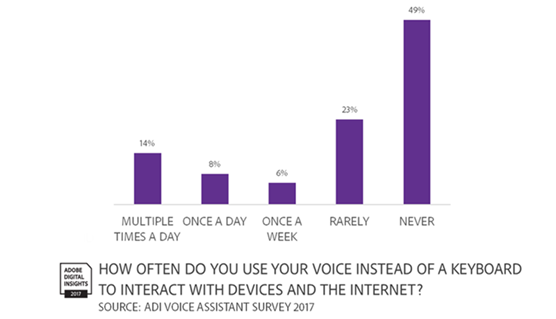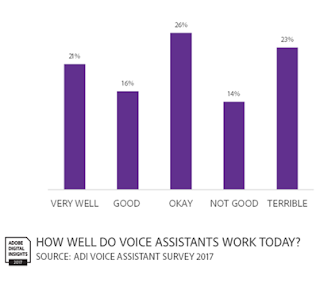By Adobe
Voice assistant
technology isn’t a new concept, but with advancements in artificial
intelligence and machine learning, adoption has grown in recent years. A report
by Gartner echoed this, as it expects 20% of user interactions with smartphones will
take place via voice assistant technologies by 2019. Voice-enabled
devices and digital assistants allow consumers to engage through one of the
most natural forms of communication.
technology isn’t a new concept, but with advancements in artificial
intelligence and machine learning, adoption has grown in recent years. A report
by Gartner echoed this, as it expects 20% of user interactions with smartphones will
take place via voice assistant technologies by 2019. Voice-enabled
devices and digital assistants allow consumers to engage through one of the
most natural forms of communication.
With a new generation
of products driving innovation and consumer appetite, the latest Adobe
Analytics data shows that online sales of voice-enabled devices grew 39% year
over year (YoY). However, a study by Adobe showed that voice assistants may not
be too popular with everyone.
of products driving innovation and consumer appetite, the latest Adobe
Analytics data shows that online sales of voice-enabled devices grew 39% year
over year (YoY). However, a study by Adobe showed that voice assistants may not
be too popular with everyone.
To help consumers and
retailers alike understand this surge, an analysis by Adobe Digital Insights shares
insights into the boom of voice-enabled device market. Some insights include:
retailers alike understand this surge, an analysis by Adobe Digital Insights shares
insights into the boom of voice-enabled device market. Some insights include:
1.
Google
Home Brings In The Cash, But Echo Dot Takes Lead In Units
According to ADI, Google
Home’s release in early November helped spur huge holiday sales, selling more
units than the Amazon Echo Dot (by a marginal 3%) over the course of the
holidays at nonproprietary retailers. It has since lost ground to the Echo Dot
but maintains its lead over the more expensive Echo.
Home Brings In The Cash, But Echo Dot Takes Lead In Units
According to ADI, Google
Home’s release in early November helped spur huge holiday sales, selling more
units than the Amazon Echo Dot (by a marginal 3%) over the course of the
holidays at nonproprietary retailers. It has since lost ground to the Echo Dot
but maintains its lead over the more expensive Echo.
In terms of revenue, however, Google Home
maintains a steady lead over all other devices both during and after the
holiday at nonproprietary retailers.
maintains a steady lead over all other devices both during and after the
holiday at nonproprietary retailers.
Not only are the devices selling well, but
they are also building a strong community for content creators online. There
are currently 778,000 connections to voice assistants on IFTTT (a
site that facilitates the customization of internet-connected devices), and
that number is growing each year. These types of sites are helping to drive
excitement and increased use of voice assistant devices, such as smarthome
speakers.
they are also building a strong community for content creators online. There
are currently 778,000 connections to voice assistants on IFTTT (a
site that facilitates the customization of internet-connected devices), and
that number is growing each year. These types of sites are helping to drive
excitement and increased use of voice assistant devices, such as smarthome
speakers.
2.
The
Growth Opportunity
The
Growth Opportunity
Even with booming holiday sales and growth on
sites like IFTTT, the voice assistant market has plenty of room for
improvement. Outside of the holiday season, unit sales have seen a respectable
39% growth YoY – but ADI’s consumer survey found that 49% of the people
surveyed don’t use voice assistants. Half of the potential market still
needs convincing that voice assistants are the wave of the future, and
companies need to ensure that newcomers have a positive first impression.
sites like IFTTT, the voice assistant market has plenty of room for
improvement. Outside of the holiday season, unit sales have seen a respectable
39% growth YoY – but ADI’s consumer survey found that 49% of the people
surveyed don’t use voice assistants. Half of the potential market still
needs convincing that voice assistants are the wave of the future, and
companies need to ensure that newcomers have a positive first impression.
37% of people reported that their experiences with voice assistants are not up
to par with their standards. They described their interactions with voice
assistants as either “not good” or simply “terrible”. However, the excitement
for the devices is there, and sales are growing, and improving customer delight
could lead to a healthy increase in sales.
For more information
on the rise of voice assistants, please check out this blogpost by Adobe Digital Insights
on the rise of voice assistants, please check out this blogpost by Adobe Digital Insights
For the LATEST tech updates,
FOLLOW us on our Twitter
LIKE us on our FaceBook
SUBSCRIBE to us on our YouTube Channel!








